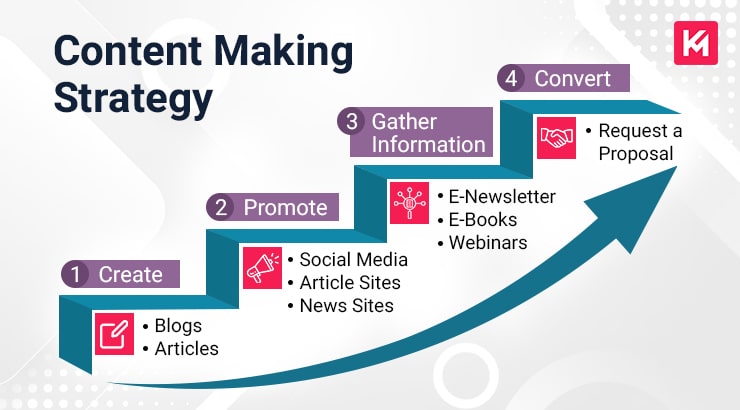Search engine optimization (SEO) is considered as one of the most important factors in Internet Marketing. Business-owners build websites with the aim of adding an advantage to the business profits. Obviously, who will want to invest in something not worthy of generating profits? Noooooobbboooooodyyyyyyyyyyyyyyyy!!!
How does this process of revenue-generation work?
First and foremost, a website that aligns with marketing goals is built. Then, it goes to the SEO department who aims to take it on the top of SERP. Because, the higher the RANKINGS, the more the PROFIT-GENERATION.
So, how to make a website rank on the top of SERP?
Here you go with the information you need!
1. Choose The Keywords Wisely
Before beginning with SEO efforts, it is necessary to prepare a list of keywords a business is willing to target.
Tips To Choose The Keywords
- Choose different types of keywords – Informational, Commercial & Transactional. Don’t choose only one type of keyword.
- Always filter keywords based on volume and keyword difficulty.
- Include local keywords in your list like – Burger near me, Fried Sandwich in Toronto.
- You must have a proper keyword mapping strategy. (A strategy where you decide which keywords to target for particular pages).
- Find LSI versions of each focus keyword. (Tip: You can find these keywords in Google Autocomplete and People Also Ask section of Google)
2. Content
There is no second thought to the thought – ‘Content reigns supreme’. No technique and method work as effectively as highly-researched and easy-to-understand content. There are various SEO aspects for which we need content – Articles, Blogs, Landing Pages (On Generic Keywords and Location Specific), Meta Data )
Tips To Write Content That Takes You On First Page
- Write highly-researched and easy to understand content.
- Don’t believe in writing a specific word limit. Write what is needed and avoid mentioning unnecessary details.
- Don’t have a blind faith in AI tools like ChatGPT, CopyAI.
- Writing paraphrased and spinned content won’t benefit you.
- Embed keywords naturally. Don’t force keywords in content.
(Tip: If the keyword is “Best Coffee Ontario”, don’t use the exact-match version. Try incorporating prepositions and determiners like – Best Coffee in Ontario. For example: I can bet that the best coffee is sold in Ontario. This line has everything that our focus keyword demands.)
- Don’t stuff irrelevant keywords in the content for the sake of making certain keywords rank.
- Include relevant examples and case studies in your content for better understanding.
3. Backlink Building
Backlinks are indispensable for building credibility and authority. Besides, Google has recognized it as one of the crucial ranking factors. Without a strong backlink profile, keyword rankings cannot be achieved.
How To Build Quality Backlinks?
Building quality backlinks is not a big deal. All you need is a good understanding –
- Make sure your website has high quality content because it is the first thing that other businesses with whom you want to link look for.
- Guest posting is one of the best ways to acquire high quality
- Use social media to promote your content and attract backlinks.
- Reach out to other website owners and offer to exchange links.
- Submit your website to relevant directories and industry-specific websites.
- Use broken link building strategies to find broken links on other websites and offer to replace them with a link to your own content.
- Participate in online communities and forums related to your industry and include a link to your website in your signature or profile.
- Use influencer marketing to get industry leaders to link to your content.
- Create infographics or other visual content that can be easily shared and linked back to.
- Monitor your backlinks regularly and disavow any low-quality or spammy links that could harm your website’s reputation.
4. Mobile Responsiveness
It has been observed that websites which lack responsiveness on all portable devices, fail to rank in SERP. So, it is quintessentially essential to bring responsiveness in all the portable devices – mobile phones, tablets etc.
Tips to bring mobile responsiveness
- Use a responsive design framework, such as Bootstrap or Foundation, to ensure your website layout adapts to different screen sizes.
- Optimize images and videos to reduce load time and improve website speed.
- Use CSS media queries to adjust the layout and content of your website based on the device screen size.
- Use relative units for font sizes and other measurements to ensure your website scales properly on different devices.
- Minimize the use of pop-ups and other intrusive elements that can detract from the user experience on mobile devices.
- Ensure that all clickable elements are large enough and have enough spacing to be easily clickable on a touch screen device.
- Use responsive navigation menus that collapse or expand based on the device screen size.
- Test your website on different devices and screen sizes to ensure it is responsive and functional.
- Implement lazy loading techniques to ensure that images and other resources are loaded only when needed, improving website speed.
- Consider using a mobile-first design approach, where the website design is optimized for mobile devices first, and then scaled up for larger screens.
5. Use Alt Tags
Alt tags, also known as alternative text tags, are an important part of web design and development. They provide a description of the content of an image on a website, which can be read by screen readers and search engines.
One of the primary reasons to use alt tags is to ensure accessibility for people with visual impairments. Screen readers rely on alt tags to provide a description of the content of images on a website. Without alt tags, the user may not be able to understand the context of the image and may miss important information.
Alt tags are also important for search engine optimization (SEO). Search engines use alt tags to understand the content of images on a website and to rank them in search results. Including relevant keywords in alt tags can help improve the ranking of your website in search results.
Another reason to use alt tags is to address image loading issues. Sometimes images fail to load properly on a website due to slow internet connections or technical problems. In such cases, alt tags can be used to provide a description of the image, ensuring that the user still has access to the content even if the image fails to load.
Tips To Use Alt Tags
Be descriptive: Alt tags should accurately describe the content of the image. Use concise and descriptive language to provide context for the image.
- Include keywords
- Use proper capitalization
- Don’t use “image of” or “picture of”
- Keep it short
- Avoid stuffing keywords
- Be mindful of context
- Use alt tags for decorative images
- Test your alt tags
- Update alt tags regularly
Conclusion
To rank on the first page of Google, it is important to follow the right techniques. The first step is to build a website that aligns with marketing goals, then optimize it with SEO. To make a website rank on the top of SERP, it is important to choose keywords wisely, include highly-researched and easy-to-understand content, build quality backlinks, ensure mobile responsiveness, and use alt tags. By following these techniques, a website can increase its credibility and authority, generate higher rankings, and drive more profits. Therefore, a well-executed SEO strategy can lead to significant business growth and success.
Also Read This Article: How to Rank Higher on Yelp


